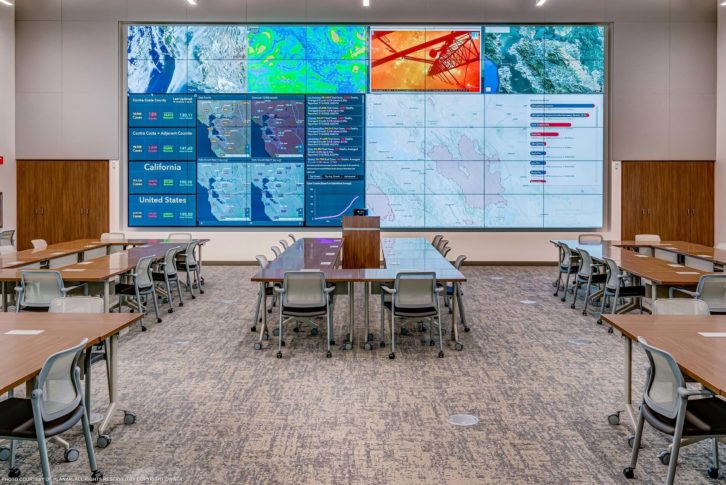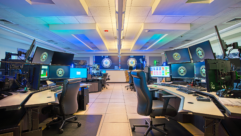
In June 2020, Contra Costa County opened its new Public Safety and Emergency Operations Center (EOC), a 38,000-square-foot building fitted with the latest in disaster management and public safety technology. The new building houses the Office of the Sheriff Administration and includes a high-tech Emergency Operations Center that serves as a command for emergency management in the event of a crisis or natural disaster. At the visual heart of the state-of-the-art EOC is a nearly 32-foot-long, 13.5-foot-high Clarity Matrix G3 LCD Video Wall System in an 8-wide by 6-high configuration. The video wall functions as a source for displaying a range of information like real-time maps, news updates, live videos and more.
The center’s real-time visualization is supported with RGB Spectrum’s Galileo display processor coupled with its Zio AV-over-IP platform. Contra Costa County needed support for diverse signal sources, ability to disseminate information to local and remote locations simultaneously, and exceptional 4K image quality. Rosendin Electric, a highly experienced audio-visual design-build integrator based in San Jose, California, was commissioned to design and deploy the Center’s visualization system.
The Galileo processor consolidates critical visuals and data to provide a centralized, correlated view of the tactical situation. Source signals are displayed in windows of any size, anywhere. Operators can easily switch and route inputs, choose customizable, preset display layouts, and pan and zoom around items of interest. Operators collaboratively view this information for purposes of assessment, analysis and decision-making. A critical requirement was to share visuals and data both throughout the EOC and with agencies offsite. Critical information is simultaneously displayed on the video wall and shared with remote facilities via IP video streams on local area (LAN) and wide area (WAN) networks, with a VPN for added security. To share visuals with remote locations, the Zio AV-over-IP platform supports both baseband inputs and IP streams at up to 4K60p resolution, including maps, news feeds, TV broadcasts, interagency communications, Internet data, traffic management systems, surveillance cameras, and the Galileo video wall itself.
All video, audio, and control data are converted to IP packets that are switched and routed to any location on the network via a LAN/ VPN. Zio encoders ingest baseband inputs and encode them into H.264 streams which are fed to recipients inside and outside facility. The Galileo processor and Zio decoders display IP streams from Zio encoders as well as third party IP cameras and other H.264 devices. The EOC is an information hub equipped with 13 conference rooms, 22 offices, and a press briefing auditorium, all of which have access to the content of the Galileo/Zio system. Individual visuals, portions of the video wall, or the entire video wall image can be shared throughout the facility and with remote locations. Communications are bi-directional, with conference rooms and remote locations able to send visuals for display on the EOC’s video wall. Staff operate the system using a third-party touch screen controller able to quickly change display layouts and route signals.










